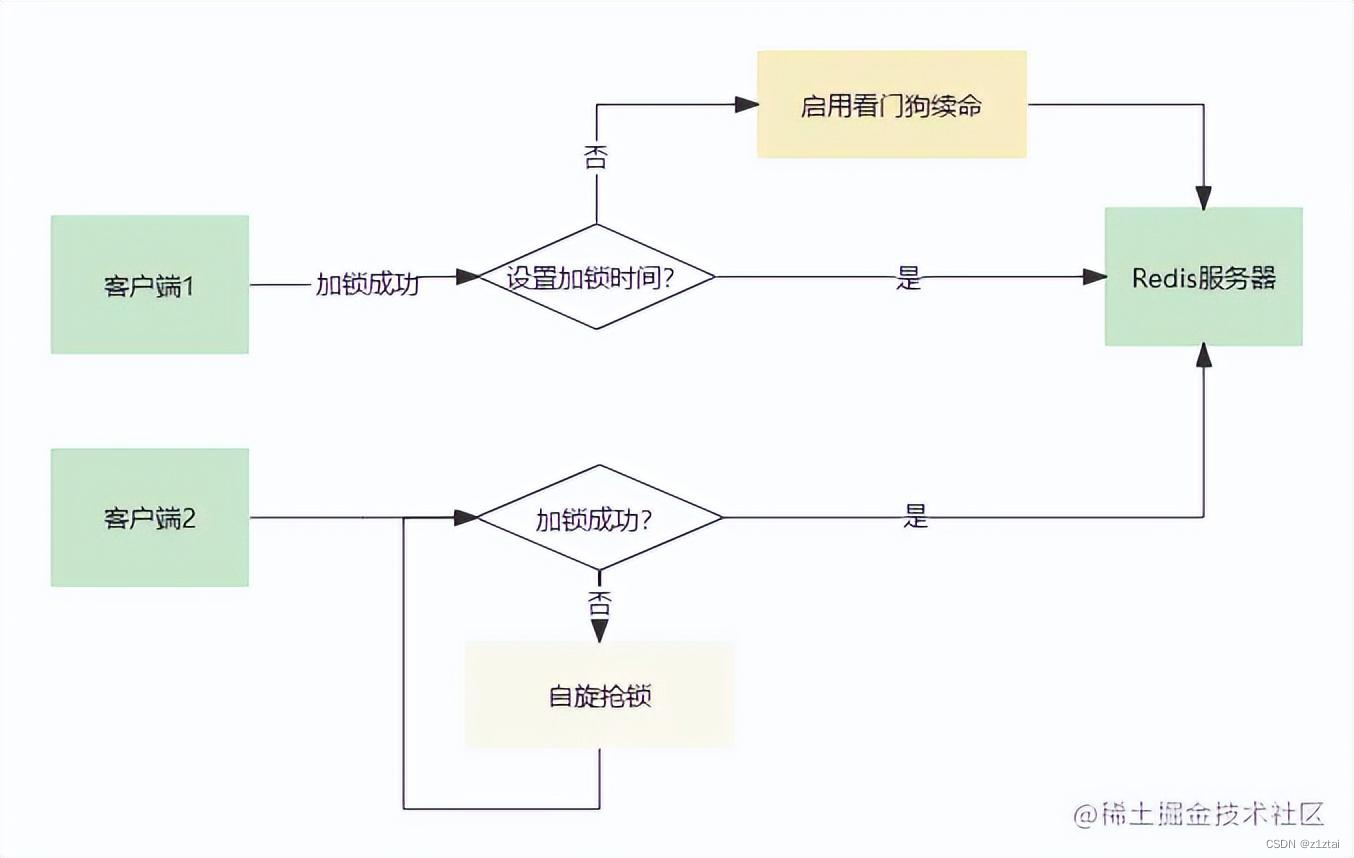2023的金三银四来的没想象中那么激烈,一个朋友前段时间投了几十家,多数石沉大海,好不容易等来面试机会,就恰好被问到项目中关于分布式锁的应用,后涉及Redisson实现分布式锁的原理,答不上来。
锁的可重入性
我们都知道,Java中synchronized和lock都支持可重入,synchronized的锁关联一个线程持有者和一个计数器。当一个线程请求成功后,JVM会记下持有锁的线程,并将计数器计为1。此时其他线程请求该锁,则必须等待。
而该持有锁的线程如果再次请求这个锁,就可以再次拿到这个锁,同时计数器会递增。当线程退出一个synchronized方法/块时,计数器会递减,如果计数器为0则释放该锁;
在ReentrantLock中,底层的 AQS 对应的state 同步状态值表示线程获取该锁的可重入次数,通过CAS方式进行设置,在默认情况下,state的值为0 表示当前锁没有被任何线程持有,原理类似。
所以如果想要实现可重入性,可能须有一个计数器来控制重入次数,实际Redisson确实是这么做的。
好的我们通过Redisson客户端进行设置,并循环3次,模拟锁重入:
for(int i = 0; i < 3; i++) {
RedissonLockUtil.tryLock("distributed:lock:distribute_key", TimeUnit.SECONDS, 20, 100);
}
连接Redis客户端进行查看:

可以看到,我们设置的分布式锁是存在一个hash结构中,value看起来是循环的次数3,key就不怎么认识了,那这个key是怎么设置进去的呢,另外为什么要设置成为Hash类型呢?
加锁
我们先来看看普通的分布式锁的上锁流程:

说明:
- 客户端在进行加锁时,会校验如果业务上没有设置持有锁时长leaseTime,会启动看门狗来每隔10s进行续命,否则就直接以leaseTime作为持有的时长;
- 并发场景下,如果客户端1锁还未释放,客户端2尝试获取,加锁必然失败,然后会通过发布订阅模式来订阅Key的释放通知,并继续进入后续的抢锁流程。
public boolean tryLock(long waitTime, long leaseTime, TimeUnit unit) throws InterruptedException {
long time = unit.toMillis(waitTime);
long current = System.currentTimeMillis();
long threadId = Thread.currentThread().getId();
Long ttl = this.tryAcquire(waitTime, leaseTime, unit, threadId);
if (ttl == null) {
return true;
} else {
// 订阅分布式Key对应的消息,监听其它锁持有者释放,锁没有释放的时候则会等待,直到锁释放的时候会执行下面的while循环
CompletableFuture subscribeFuture = this.subscribe(threadId);
subscribeFuture.get(time, TimeUnit.MILLISECONDS);
try {
do {
// 尝试获取锁
ttl = this.tryAcquire(waitTime, leaseTime, unit, threadId);
// 竞争获取锁成功,退出循环,不再竞争。
if (ttl == null) {
return true;
}
// 利用信号量机制阻塞当前线程相应时间,之后再重新获取锁
if (ttl >= 0L && ttl < time) {
((RedissonLockEntry)this.commandExecutor.getNow(subscribeFuture)).getLatch().tryAcquire(ttl, TimeUnit.MILLISECONDS);
} else {
((RedissonLockEntry)this.commandExecutor.getNow(subscribeFuture)).getLatch().tryAcquire(time, TimeUnit.MILLISECONDS);
}
time -= System.currentTimeMillis() - currentTime;
} while(time > 0L);
} finally {
// 竞争锁成功后,取消订阅该线程Id事件
this.unsubscribe((RedissonLockEntry)this.commandExecutor.getNow(subscribeFuture), threadId);
}
}
}
}
RFuture<Long> tryAcquireAsync(long leaseTime, TimeUnit unit, final long threadId) {
// 如果设置了持有锁的时长,直接进行尝试加锁操作
if (leaseTime != -1L) {
return this.tryLockInnerAsync(leaseTime, unit, threadId, RedisCommands.EVAL_LONG);
} else {
// 未设置加锁时长,在加锁成功后,启动续期任务,初始默认持有锁时间是30s
RFuture<Long> ttlRemainingFuture = this.tryLockInnerAsync(this.commandExecutor.getConnectionManager().getCfg().getLockWatchdogTimeout(), TimeUnit.MILLISECONDS, threadId, RedisCommands.EVAL_LONG);
ttlRemainingFuture.addListener(new FutureListener<Long>() {
public void operationComplete(Future<Long> future) throws Exception {
if (future.isSuccess()) {
Long ttlRemaining = (Long)future.getNow();
if (ttlRemaining == null) {
RedissonLock.this.scheduleExpirationRenewal(threadId);
}
}
}
});
return ttlRemainingFuture;
}
}
我们都知道Redis执行Lua脚本具有原子性,所以在尝试加锁的下层,Redis主要执行了一段复杂的lua脚本:
-- 不存在该key时
if (redis.call('exists', KEYS[1]) == 0) then
-- 新增该锁并且hash中该线程id对应的count置1
redis.call('hincrby', KEYS[1], ARGV[2], 1);
-- 设置过期时间
redis.call('pexpire', KEYS[1], ARGV[1]);
return nil;
end;
-- 存在该key 并且 hash中线程id的key也存在
if (redis.call('hexists', KEYS[1], ARGV[2]) == 1) then
-- 线程重入次数++
redis.call('hincrby', KEYS[1], ARGV[2], 1);
redis.call('pexpire', KEYS[1], ARGV[1]);
return nil;
end;
return redis.call('pttl', KEYS[1]);
参数说明:
- KEYS[1]:对应我们设置的分布式key,即:distributed🔒distribute_key
- ARGV[1]:业务自定义的加锁时长或者默认的30s;
- ARGV[2]: 具体的客户端初始化连接UUID+线程ID: 9d8f0907-1165-47d2-8983-1e130b07ad0c:1
我们从上面的脚本中可以看出核心逻辑其实不难:
- 如果分布式锁Key未被任何端持有,直接根据“客户端连接ID+线程ID” 进行初始化设置,并设置重入次数为1,并设置Key的过期时间;
- 否则重入次数+1,并重置过期时间;
锁续命
接下来看看scheduleExpirationRenewal续命是怎么做的呢?
private void scheduleExpirationRenewal(final long threadId) {
if (!expirationRenewalMap.containsKey(this.getEntryName())) {
Timeout task = this.commandExecutor.getConnectionManager().newTimeout(new TimerTask() {
public void run(Timeout timeout) throws Exception {
// 执行续命操作
RFuture<Boolean> future = RedissonLock.this.renewExpirationAsync(threadId);
future.addListener(new FutureListener<Boolean>() {
public void operationComplete(Future<Boolean> future) throws Exception {
RedissonLock.expirationRenewalMap.remove(RedissonLock.this.getEntryName());
...
// 续命成功,继续
if ((Boolean)future.getNow()) {
RedissonLock.this.scheduleExpirationRenewal(threadId);
}
}
});
}
}, this.internalLockLeaseTime / 3L, TimeUnit.MILLISECONDS);
}
}
Tip小知识点:
续期是用的什么定时任务执行的?
Redisson用netty的HashedWheelTimer做命令重试机制,原因在于一条redis命令的执行不论成功或者失败耗时都很短,而HashedWheelTimer是单线程的,系统性能开销小。
而在上面的renewExpirationAsync中续命操作的执行核心Lua脚本要做的事情也非常的简单,就是给这个Key的过期时间重新设置为指定的30s.
if (redis.call('hexists', KEYS[1], ARGV[2]) == 1) then
redis.call('pexpire', KEYS[1], ARGV[1]);
return 1;
end;
return 0;
释放锁
释放锁主要是除了解锁本省,另外还要考虑到如果存在续期的情况,要将续期任务删除:
public RFuture<Void> unlockAsync(long threadId) {
// 解锁
RFuture<Boolean> future = this.unlockInnerAsync(threadId);
CompletionStage<Void> f = future.handle((opStatus, e) -> {
// 解除续期
this.cancelExpirationRenewal(threadId);
...
});
return new CompletableFutureWrapper(f);
}
在unlockInnerAsync内部,Redisson释放锁其实核心也是执行了如下一段核心Lua脚本:
// 校验是否存在
if (redis.call('hexists', KEYS[1], ARGV[3]) == 0) then
return nil;
end;
// 获取加锁次数,校验是否为重入锁
local counter = redis.call('hincrby', KEYS[1], ARGV[3], -1);
// 如果为重入锁,重置过期时间,锁本身不释放
if (counter > 0) then
redis.call('pexpire', KEYS[1], ARGV[2]);
return 0;
// 删除Key
else redis.call('del', KEYS[1]);
// 通知阻塞的客户端可以抢锁啦
redis.call('publish', KEYS[2], ARGV[1]);
return 1;
end;
return nil;
Redisson实现分布式锁的原理—加解锁
2023-03-16 09:46·互联网高级架构师
2023的金三银四来的没想象中那么激烈,一个朋友前段时间投了几十家,多数石沉大海,好不容易等来面试机会,就恰好被问到项目中关于分布式锁的应用,后涉及Redisson实现分布式锁的原理,答不上来。
锁的可重入性
我们都知道,Java中synchronized和lock都支持可重入,synchronized的锁关联一个线程持有者和一个计数器。当一个线程请求成功后,JVM会记下持有锁的线程,并将计数器计为1。此时其他线程请求该锁,则必须等待。
而该持有锁的线程如果再次请求这个锁,就可以再次拿到这个锁,同时计数器会递增。当线程退出一个synchronized方法/块时,计数器会递减,如果计数器为0则释放该锁;
在ReentrantLock中,底层的 AQS 对应的state 同步状态值表示线程获取该锁的可重入次数,通过CAS方式进行设置,在默认情况下,state的值为0 表示当前锁没有被任何线程持有,原理类似。
所以如果想要实现可重入性,可能须有一个计数器来控制重入次数,实际Redisson确实是这么做的。
好的我们通过Redisson客户端进行设置,并循环3次,模拟锁重入:
for(int i = 0; i < 3; i++) {
RedissonLockUtil.tryLock(“distributed🔒distribute_key”, TimeUnit.SECONDS, 20, 100);
}
连接Redis客户端进行查看:
可以看到,我们设置的分布式锁是存在一个hash结构中,value看起来是循环的次数3,key就不怎么认识了,那这个key是怎么设置进去的呢,另外为什么要设置成为Hash类型呢?
加锁
我们先来看看普通的分布式锁的上锁流程:
说明:
客户端在进行加锁时,会校验如果业务上没有设置持有锁时长leaseTime,会启动看门狗来每隔10s进行续命,否则就直接以leaseTime作为持有的时长;
并发场景下,如果客户端1锁还未释放,客户端2尝试获取,加锁必然失败,然后会通过发布订阅模式来订阅Key的释放通知,并继续进入后续的抢锁流程。
public boolean tryLock(long waitTime, long leaseTime, TimeUnit unit) throws InterruptedException {
long time = unit.toMillis(waitTime);
long current = System.currentTimeMillis();
long threadId = Thread.currentThread().getId();
Long ttl = this.tryAcquire(waitTime, leaseTime, unit, threadId);
if (ttl == null) {
return true;
} else {
// 订阅分布式Key对应的消息,监听其它锁持有者释放,锁没有释放的时候则会等待,直到锁释放的时候会执行下面的while循环
CompletableFuture subscribeFuture = this.subscribe(threadId);
subscribeFuture.get(time, TimeUnit.MILLISECONDS);
try {
do {
// 尝试获取锁
ttl = this.tryAcquire(waitTime, leaseTime, unit, threadId);
// 竞争获取锁成功,退出循环,不再竞争。
if (ttl == null) {
return true;
}
// 利用信号量机制阻塞当前线程相应时间,之后再重新获取锁
if (ttl >= 0L && ttl < time) {
((RedissonLockEntry)this.commandExecutor.getNow(subscribeFuture)).getLatch().tryAcquire(ttl, TimeUnit.MILLISECONDS);
} else {
((RedissonLockEntry)this.commandExecutor.getNow(subscribeFuture)).getLatch().tryAcquire(time, TimeUnit.MILLISECONDS);
}
time -= System.currentTimeMillis() - currentTime;
} while(time > 0L);
} finally {
// 竞争锁成功后,取消订阅该线程Id事件
this.unsubscribe((RedissonLockEntry)this.commandExecutor.getNow(subscribeFuture), threadId);
}
}
}
}
RFuture tryAcquireAsync(long leaseTime, TimeUnit unit, final long threadId) {
// 如果设置了持有锁的时长,直接进行尝试加锁操作
if (leaseTime != -1L) {
return this.tryLockInnerAsync(leaseTime, unit, threadId, RedisCommands.EVAL_LONG);
} else {
// 未设置加锁时长,在加锁成功后,启动续期任务,初始默认持有锁时间是30s
RFuture ttlRemainingFuture = this.tryLockInnerAsync(this.commandExecutor.getConnectionManager().getCfg().getLockWatchdogTimeout(), TimeUnit.MILLISECONDS, threadId, RedisCommands.EVAL_LONG);
ttlRemainingFuture.addListener(new FutureListener() {
public void operationComplete(Future future) throws Exception {
if (future.isSuccess()) {
Long ttlRemaining = (Long)future.getNow();
if (ttlRemaining == null) {
RedissonLock.this.scheduleExpirationRenewal(threadId);
}
}
}
});
return ttlRemainingFuture;
}
}
我们都知道Redis执行Lua脚本具有原子性,所以在尝试加锁的下层,Redis主要执行了一段复杂的lua脚本:
– 不存在该key时
if (redis.call(‘exists’, KEYS[1]) == 0) then
– 新增该锁并且hash中该线程id对应的count置1
redis.call(‘hincrby’, KEYS[1], ARGV[2], 1);
– 设置过期时间
redis.call(‘pexpire’, KEYS[1], ARGV[1]);
return nil;
end;
– 存在该key 并且 hash中线程id的key也存在
if (redis.call(‘hexists’, KEYS[1], ARGV[2]) == 1) then
– 线程重入次数++
redis.call(‘hincrby’, KEYS[1], ARGV[2], 1);
redis.call(‘pexpire’, KEYS[1], ARGV[1]);
return nil;
end;
return redis.call(‘pttl’, KEYS[1]);
参数说明:
KEYS[1]:对应我们设置的分布式key,即:distributed🔒distribute_key
ARGV[1]:业务自定义的加锁时长或者默认的30s;
ARGV[2]: 具体的客户端初始化连接UUID+线程ID: 9d8f0907-1165-47d2-8983-1e130b07ad0c:1
我们从上面的脚本中可以看出核心逻辑其实不难:
如果分布式锁Key未被任何端持有,直接根据“客户端连接ID+线程ID” 进行初始化设置,并设置重入次数为1,并设置Key的过期时间;
否则重入次数+1,并重置过期时间;
锁续命
接下来看看scheduleExpirationRenewal续命是怎么做的呢?
private void scheduleExpirationRenewal(final long threadId) {
if (!expirationRenewalMap.containsKey(this.getEntryName())) {
Timeout task = this.commandExecutor.getConnectionManager().newTimeout(new TimerTask() {
public void run(Timeout timeout) throws Exception {
// 执行续命操作
RFuture future = RedissonLock.this.renewExpirationAsync(threadId);
future.addListener(new FutureListener() {
public void operationComplete(Future future) throws Exception {
RedissonLock.expirationRenewalMap.remove(RedissonLock.this.getEntryName());
…
// 续命成功,继续
if ((Boolean)future.getNow()) {
RedissonLock.this.scheduleExpirationRenewal(threadId);
}
}
});
}
}, this.internalLockLeaseTime / 3L, TimeUnit.MILLISECONDS);
}
}
Tip小知识点:
续期是用的什么定时任务执行的?
Redisson用netty的HashedWheelTimer做命令重试机制,原因在于一条redis命令的执行不论成功或者失败耗时都很短,而HashedWheelTimer是单线程的,系统性能开销小。
而在上面的renewExpirationAsync中续命操作的执行核心Lua脚本要做的事情也非常的简单,就是给这个Key的过期时间重新设置为指定的30s.
if (redis.call(‘hexists’, KEYS[1], ARGV[2]) == 1) then
redis.call(‘pexpire’, KEYS[1], ARGV[1]);
return 1;
end;
return 0;
释放锁
释放锁主要是除了解锁本省,另外还要考虑到如果存在续期的情况,要将续期任务删除:
public RFuture unlockAsync(long threadId) {
// 解锁
RFuture future = this.unlockInnerAsync(threadId);
CompletionStage f = future.handle((opStatus, e) -> {
// 解除续期
this.cancelExpirationRenewal(threadId);
…
});
return new CompletableFutureWrapper(f);
}
在unlockInnerAsync内部,Redisson释放锁其实核心也是执行了如下一段核心Lua脚本:
// 校验是否存在
if (redis.call('hexists', KEYS[1], ARGV[3]) == 0) then
return nil;
end;
// 获取加锁次数,校验是否为重入锁
local counter = redis.call('hincrby', KEYS[1], ARGV[3], -1);
// 如果为重入锁,重置过期时间,锁本身不释放
if (counter > 0) then
redis.call('pexpire', KEYS[1], ARGV[2]);
return 0;
// 删除Key
else redis.call(‘del’, KEYS[1]);
// 通知阻塞的客户端可以抢锁啦
redis.call(‘publish’, KEYS[2], ARGV[1]);
return 1;
end;
return nil;
其中:
- KEYS[1]: 分布式锁
- KEYS[2]: redisson_lock_channel:{分布式锁} 发布订阅消息的管道名称
- ARGV[1]: 发布的消息内容
- ARGV[2]: 锁的过期时间
- ARGV[3]: 线程ID标识名称
其它问题
- 红锁这么火,但真的靠谱么?
- Redisson公平锁是什么情况?





















 941
941











 被折叠的 条评论
为什么被折叠?
被折叠的 条评论
为什么被折叠?








